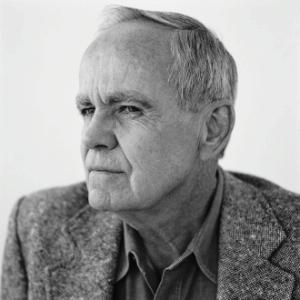The Lure of the Archive (IV): Spencer Janssen researches Cormac McCarthy’s papers at the Wittliff Collections

The English Department encourages its undergraduates to pursue serious archival research, offering seed grants of $150 to any student with a research proposal that requires travel. This year, our undergraduates traveled to locales from Texas State-San Marcos and the University of Indiana to the British Library and an abbey in French Normandy, in pursuit of authors ranging from Cormac McCarthy and Ray Bradbury to Oscar Wilde and Aimé Césaire. Here in a new series on the blog, we’re sharing the archival reflections of a number of these undergraduates.
Fourth in the series is a reflection from Spencer Janssen (’12), who visited the Cormac McCarthy papers, which are located in the Wittliff Collections at Texas State University.

My initiation into archival research began at the Wittliff Collections, housed at Texas State-San Marcos, an hour’s drive from Austin. The Wittliff Collections specialize in Southwestern writers like playwright Sam Shepard and novelist Cormac McCarthy (the artist at the center of my senior thesis), and have a distinctly Southwestern flair. During off-hours, you’re barred from entry by an enormous wood-framed door, fortified with a black iron gate. During business hours, the enormous door swings open—and you step into the vestibule, where you are immediately greeted by cream white walls bordered with light brown wood paneling, the alternating tones of auburn-checkered carpets, and Kate Breaky’s Las Sombras photogram exhibition, in which Southwestern flora and fauna are entombed in an eternal, material shadow. The architecture and decor coalesce into a harmonic singularity, one which evokes the Texas plain as a restful idyll.
From the entrance, you can see what I came to think of as the scholar’s sacristy—the archival reading room. In the hallway approaching the reading room, there are a number of relics on display: a reproduction of McCarthy’s own Olivetti Lettera 32 typewriter, annotated typescript pages from the manuscripts of The Road and No Country for Old Men, and first print editions of The Orchard Keeper, Child of God, and Blood Meridian. The McCarthy papers are considered, in the words of archivist Katie Salzmann, the archive’s “coup de grâce.”
I had come to the Wittliff Collections to look at the manuscripts of Blood Meridian and other materials related to its composition. In a sense, the “Southwest” evoked by the Wittliff Collections’ ambience is the exact opposite of the region as described in Blood Meridian, McCarthy’s magnum opus. In the novel, the border region is an endless void littered with the bones of beast and man alike, wherein shadows of beings seem to move of their own accord and the only architecture likely to be encountered is that of ramshackle hovels, mud haciendas, or the stone ruins of the Anasazi.
My research trip consisted of five alternately panic-stricken and ecstatic days of intense investigation. My primary goal was to comb through the drafts of Blood Meridian, and on the first day, I mainly tried to situate myself in relation to the massive amount of Blood Meridian material contained in the Wittliff Collections. Katie Salzmann (the archivist) was extremely helpful: she explained that the order of the fifteen boxes containing McCarthy’s correspondences, manuscripts, notations, and fragments were all kept in the precise order that they were given to the Wittliff by McCarthy. The manuscripts are filled with corrections and inquiries McCarthy scribbled to himself about his character’s situations or his own word choices. Overall the manuscripts are largely dateless: most of the time he simply labels drafts as either “Early”, “Mid”, “Mid-to-Late”, “Late”, or “Late or Final”. The marginalia, meanwhile, can be even harder to date.
At first I felt utterly sunk, overwhelmed by the task I had set before myself. However, as my research progressed, I was able to quell these self-doubts. I fell into a synchronicity with the materials at hand, making two major discoveries along the way.
The first pertains to a scene entitled “The burning tree,” which I consider pivotal to Blood Meridian. While most critics have ignored the scene or simply written it off as a falsified apotheosis, I’ve been haunted by its power since I first read the novel, and I had wondered, before arriving at the Wittliff, if McCarthy invested as much energy writing the scene as I’ve spent interpreting it. I discovered that my hunch was correct: McCarthy deliberated upon the scene for an extended period of time, drafting and redrafting, working and reworking, until it reached its final published form.
My second major discovery involves the source material McCarthy used to project his vision of violence in the borderlands. Examining a photocopy of the very research notebook McCarthy used to chart his historical sources, I was able to see exactly where he was drawing his historical information from, particularly in relation to the massacres within the novel. Strikingly, much of the extreme violence of the novel, much of what we think of as McCarthy’s personal stamp as a stylist, was inspired by what he found in the historical record.
I came away from the Wittliff with the sense that I had spent five days entering into Cormac McCarthy’s mind. I had experienced the proliferation of his thoughts as he had progressed, and had bore witness to the novel in its process of becoming: in all its available forms and fragmentations, from pupa to pièce de résistance. In the end, it is this opportunity to isolate the undiscovered qualities of a text that makes archival research so worthwhile. Through such exploration, one can uncover how the composite pieces move within and shape the material, see how they make up the whole, and find a fresh perspective on the final work of art. The archive represents a critical opportunity to the fullest extent, an opportunity that, with the right materials, can very well be endless.
Posted by Jeffrey Blevins
